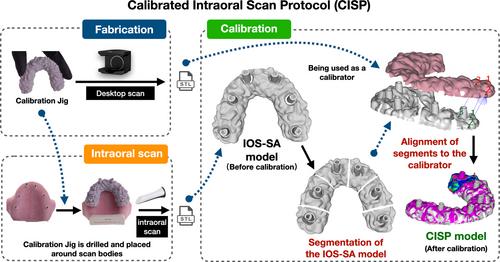To assess a newly developed intraoral scan protocol in enhancing the accuracy of complete-arch implant impressions.
Four impression approaches were applied to the same maxillary edentulous model with 6 implants: (1) intraoral scan (IOS), (2) intraoral scan with scan aid (IOS-SA), (3) calibrated intraoral scan protocol (CISP), and (4) conventional splinted open-tray impression (CONV). Each approach was repeated 10 times, and a direct scan of the model with a desktop scanner was used as a reference model. The alignment of scans and the reference model was conducted by two methods: (a) aligning all scan bodies to evaluate the overall fit, and (b) aligning the first and second scan bodies to simulate the Sheffield fit test for passive fitting of multiple implant-supported prostheses. Linear deviations from the reference model (trueness) and within each group (precision) were analyzed using Python scripts.
When aligned by all scan bodies, the CISP group exhibited comparable mean trueness (38.33 μm) and precision (45.97 μm) to the CONV group (44.30 and 47.92 μm respectively), both of which significantly outperformed the IOS group (86.82 and 83.17 μm, respectively). Furthermore, in the virtual Sheffield fit test, the CISP group achieved the highest levels of mean trueness at the end span (121.7 μm), making a linear deviation reduction of 36.7%, 60%, and 41.4% when compared to the CONV, the IOS, and the IOS-SA groups, respectively. Moreover, the CISP group (104.3 μm) displayed a remarkable 65, 182, and 86 μm advantage in precision over the CONV, IOS, and IOS-SA groups, respectively.
CISP demonstrated comparable accuracy to the gold standard, the conventional splinted open-tray impression. Furthermore, it excelled in the virtual passive fitting test.


